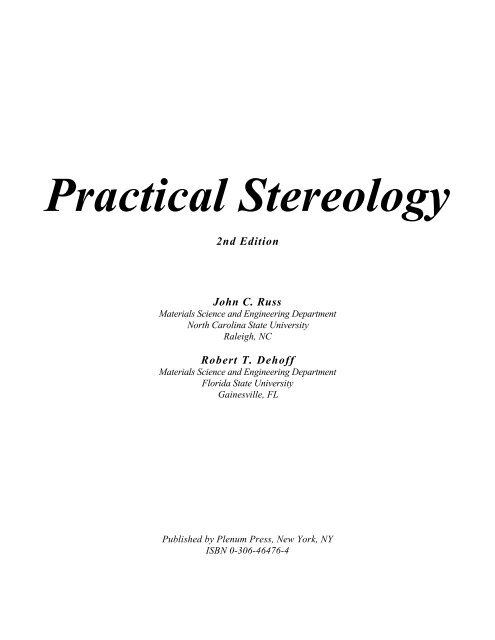
Examples include diffusive transport, villous growth, fetoplacental angiogenesis, trophoblast turnover, arterial vascular remodelling and high-resolution immuno-localization studies. This review identifies the basic features of the stereological approach before indicating several ways in which stereology has been used to aid the description and interpretation of placental functional morphology from the whole organ to the molecular level.

With these sampling and estimation tools, stereology offers a sure and safe option for characterising the total volumes, surfaces and lengths of placental compartments, the total numbers and mean sizes of nuclei or cells, and the spatial arrangements of tissues or intracellular ingredients. It incorporates the essential features of all sound study designs: (i) randomised sampling which is efficient and unbiased, and (ii) estimation tools which are simple, precise and unbiased or minimally biased. By allowing economical quantitation of microscopical sections, stereology facilitates interpretations of normal and perturbed structure from the whole organ down to the subcellular levels. It is a completely different approach from computed tomography.The value of stereology for describing the three-dimensional (3D) structural composition and spatial arrangement of biological specimens from essentially two-dimensional (2D) thin sections is indisputable. Cavalieri's principle) and statistics (mainly survey sampling inference). Stereology is based on fundamental principles of geometry (e.g. Hence, stereology is often defined as the science of estimating higher dimensional information from lower dimensional samples. It is especially useful when the sample has a lower spatial dimension than the original material. needle biopsy), projected images, and other kinds of 'sampling'. 3D microscope images), one-dimensional probes (e.g.

In addition to two-dimensional plane sections, stereology also applies to three-dimensional slabs (e.g. New innovations such as the proportionator continue to make important improvements in the efficiency of stereological procedures. Stereology is a developing science with many important innovations being developed mainly in Europe. It is an important and efficient tool in many applications of microscopy (such as petrography, materials science, and biosciences including histology, bone and neuroanatomy). Stereology is a method that utilizes random, systematic sampling to provide unbiased and quantitative data. It provides practical techniques for extracting quantitative information about a three-dimensional material from measurements made on two-dimensional planar sections of the material. It is an interdisciplinary field that is largely concerned with the three-dimensional interpretation of planar sections of materials or tissues.

In practice, it was originally defined in modern science as "the spatial interpretation of sections". Is this the first time you stumble on the word stereology?įrom its greek roots "stereo"and"logos" the term means the "science of studying solids". ISSIA Board: Aleš Kladnik, Bruno Figliuzzi, Jitka Čočková, Eric Pirard, Augusto Coppi, Johan Debayle, Karl-Anton Dorph-Petersen, Aneta Gądek-Moszczak, Dorothy E. Dvoralai Wulfsohn ( agricultural engineering, Geco Enterprises, Chile).Xiaoyan Song ( stereology in materials science, visualization simulation Beijing University of Technology, China).Ramya ( image processing, mathematical morphology and machine vision Hindustan Institute of Technology and Science, India) Peterson ( image analysis, stereology and microscopy in biomedicine The Chicago Medical School, USA) Oorschot ( stereology in biomedicine and neuroscience University of Otago, Dunedin, New Zealand) Aneta Gądek-Moszczak ( image analysis and stereology in materials science and medicine Cracow University of Technology, Poland).Karl-Anton Dorph-Petersen ( stereology in biosciences Aarhus University, Denmark).Johan Debayle ( image processing and analysis, mathematical morphology, pattern recognition and stochastic geometry, MINES Saint-Etienne, France).Augusto Coppi ( stereology in biomedicine School of Veterinary Medicine, University of Central Lancashire, Preston, UK).Eric Pirard ( particle shape analysis in geosciences University of Liège, Belgium).Jitka Čočková ( economics Institute of Physiology, Prague, Czech Republic).Images of cardiomyocyte ultrastructure were also analysed with. Bruno Figliuzzi ( image processing, stochastic geometry and materials science Mines ParisTech, France) The total volumes of the cardiomyocyte fibre and capillary structures (V s cm 3) were calculated as V s V V (s,t) V t, where V V (s,t) is the fraction of ventricular tissue occupied by the structure determined from the grid point counts (Cruz-Orive and Weibel, 1990 Mayhew, 1991).Aleš Kladnik ( image analysis and microscopy in plant biology University of Ljubljana, Slovenia).


 0 kommentar(er)
0 kommentar(er)
